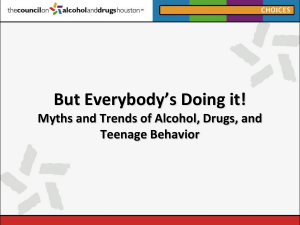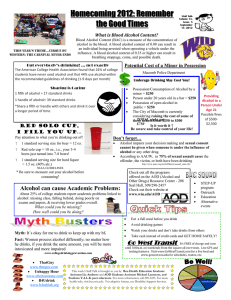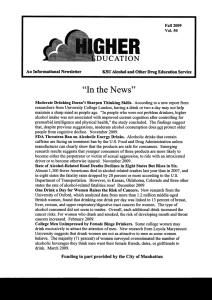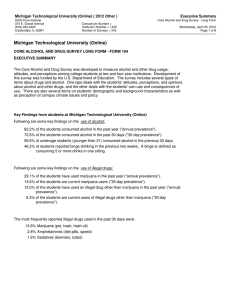Student Alcohol and Drug Use: Scope and Impact
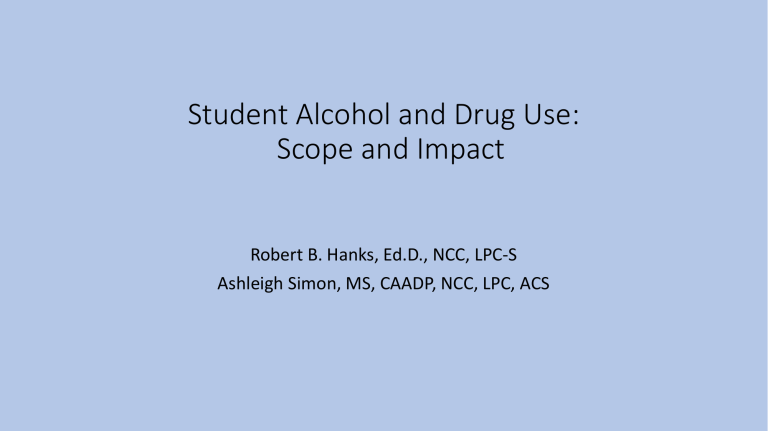
Student Alcohol and Drug Use:
Scope and Impact
Robert B. Hanks, Ed.D., NCC, LPC-S
Ashleigh Simon, MS, CAADP, NCC, LPC, ACS
CORE Alcohol and Drug Survey
Fall 2015
• Administered on-line
• 5000 students randomly selected for participation
• 325 completed survey
• Financial incentive used
Sample Demographics
• 27% freshmen
• 19% sophomores
• 24% juniors
• 29% seniors
• 1% other
• 65% female
• 73% lived off-campus
• 88% full-time students
• 51% worked part or full-time
• 70% white
• 16% African-American
Substance Use – Past 30 Days
Substance
Alcohol
Marijuana
Tobacco
Amphetamines
Sedatives
Cocaine
Hallucinogens
Designer Drugs
Synthetic Marijuana (e.g., Spice)
USA
55.1%
15.7%
18.0%
3.7%
2.5%
2.2%
2.2%
1.2%
.6%
Reference Group
68.7%
19.9%
21.1%
3.0%
1.5%
1.8%
1.3%
1.7%
(not available)
Selected Alcohol Statistics
• USA - average drinks per week = 2.2
• National average was 4.4 drinks per week
• Key finding - most students either do not drink or drink in moderation
Binge defined as 5 or more drinks at a sitting
• USA - 29.6% reported binge drinking in previous two weeks
• 43.6% was national average for binge drinking
AOD Related Consequences
Percentage
46.4% Had a hangover
41.2% Got nauseated or vomited
Consequence or Experience
24.1% Did something they later regretted
22.9% Had a memory loss
20.1% Drove a car while under the influence
19.1% Got into an argument or fight
15.3% Performed poorly on a test or important project
7.2% Were taken advantage of sexually
4.1% Had trouble with police, residence hall, or other college authorities
Campus Environment
• 84.9% said campus had alcohol and drug policies
• Of that number, 52.8% said policies were enforced
• 48% said campus had alcohol and drug prevention program
• 77.5% said campus was concerned about prevention
Campus Environment (2)
• 41.5% said they would prefer not to have alcohol at parties
• 86.6% said they would prefer not to have drugs at parties
• 16.6% reported drinking in residence halls
• 3.7% reported smoking marijuana in residence halls
AOD Use and Academic Performance
• Good students (A-B) were less likely than below average students (C-
F) to drink, use marijuana and/or other illegal drugs
AOD Counseling Referrals – Fall 2015
USA Counseling Center
Drug Type Alcohol
4
Marijuana Alcohol & Total
Marijuana
13 3 4 24 # of
Referrals
DSM-
Criteria
Met
2 7 1 2 12
Role of Student Affairs in AOD Prevention
• Policy enforcement
• Alcohol/drug free options
• Substance free housing
• Restriction of alcohol marketing on-campus
• Screening, counseling, and referral services
• Social norms marketing

